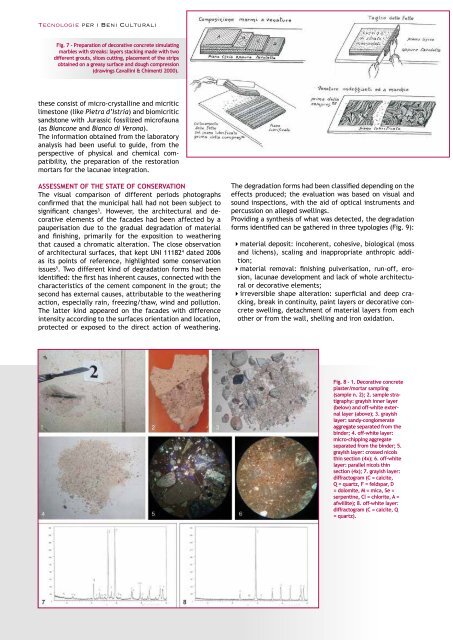You also want an ePaper? Increase the reach of your titles
YUMPU automatically turns print PDFs into web optimized ePapers that Google loves.
Tecnologie per i Beni Culturali 15<br />
Fig. 7 - Preparation of decorative concrete simulating<br />
marbles with streaks: layers stacking made with two<br />
different grouts, slices cutting, placement of the strips<br />
obtained on a greasy surface and dough compression<br />
(drawings Cavallini & Chimenti 2000).<br />
these consist of micro-crystalline and micritic<br />
limestone (like Pietra d’Istria) and biomicritic<br />
sandstone with Jurassic fossilized microfauna<br />
(as Biancone and Bianco di Verona).<br />
The information obtained from the laboratory<br />
analysis had been useful to guide, from the<br />
perspective of physical and chemical compatibility,<br />
the preparation of the restoration<br />
mortars for the lacunae integration.<br />
ASSESSMENT OF THE STATE OF CONSERVATION<br />
The visual comparison of different periods photographs<br />
confirmed that the municipal hall had not been subject to<br />
significant changes 3 . However, the architectural and decorative<br />
elements of the facades had been affected by a<br />
pauperisation due to the gradual degradation of material<br />
and finishing, primarily for the exposition to weathering<br />
that caused a chromatic alteration. The close observation<br />
of architectural surfaces, that kept UNI 11182 4 dated 2006<br />
as its points of reference, highlighted some conservation<br />
issues 5 . Two different kind of degradation forms had been<br />
identified: the first has inherent causes, connected with the<br />
characteristics of the cement component in the grout; the<br />
second has external causes, attributable to the weathering<br />
action, especially rain, freezing/thaw, wind and pollution.<br />
The latter kind appeared on the facades with difference<br />
intensity according to the surfaces orientation and location,<br />
protected or exposed to the direct action of weathering.<br />
The degradation forms had been classified depending on the<br />
effects produced; the evaluation was based on visual and<br />
sound inspections, with the aid of optical instruments and<br />
percussion on alleged swellings.<br />
Providing a synthesis of what was detected, the degradation<br />
forms identified can be gathered in three typologies (Fig. 9):<br />
4material deposit: incoherent, cohesive, biological (moss<br />
and lichens), scaling and inappropriate anthropic addition;<br />
4material removal: finishing pulverisation, run-off, erosion,<br />
lacunae development and lack of whole architectural<br />
or decorative elements;<br />
4irreversible shape alteration: superficial and deep cracking,<br />
break in continuity, paint layers or decorative concrete<br />
swelling, detachment of material layers from each<br />
other or from the wall, shelling and iron oxidation.<br />
Fig. 8 - 1. Decorative concrete<br />
plaster/mortar sampling<br />
(sample n. 2); 2. sample stratigraphy:<br />
grayish inner layer<br />
(below) and off-white external<br />
layer (above); 3. grayish<br />
layer: sandy-conglomerate<br />
aggregate separated from the<br />
binder; 4. off-white layer:<br />
micro-chipping aggregate<br />
separated from the binder; 5.<br />
grayish layer: crossed nicols<br />
thin section (4x); 6. off-white<br />
layer: parallel nicols thin<br />
section (4x); 7. grayish layer:<br />
diffractogram (C = calcite,<br />
Q = quartz, F = feldspar, D<br />
= dolomite, M = mica, Se =<br />
serpentine, Cl = chlorite, A =<br />
afwillite); 8. off-white layer:<br />
diffractogram (C = calcite, Q<br />
= quartz).


















